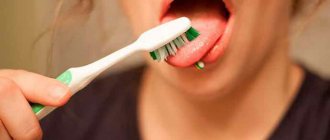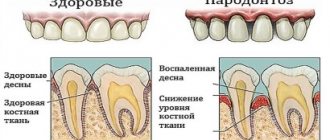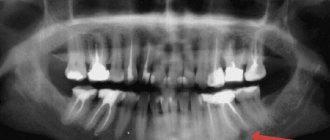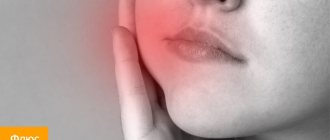What is periodontitis?
You need to know an enemy, and especially such a formidable one, by sight. Medical encyclopedias report:
“Periodontitis is an inflammatory disease of periodontal tissues.”
To the common man this definition will most likely seem incomprehensible. Therefore, in order to understand how insidious this dental disease is, it is worth remembering what periodontium is and its structure.
Periodontium is periodontal tissues whose main task is to hold the tooth in the socket.
Periodontium includes:
- Gums are soft tissues that surround part of the tooth root and protect it from external influences.
- Bone bed of the tooth or alveolar process. It consists of bone plates, and is penetrated by vessels and nerves.
- Periodontium is connective tissue that fills the space between the bone bed and the tooth itself.
- Cementum is the tissue that covers the root of the tooth.
So, periodontitis is a pathological process that affects all, without exception, periodontal structures. Beginning as inflammation of the gums, over time it spreads to the connective tissue and alveolar ridge. It is easy to guess that at a late stage the disease leads to loosening and loss of teeth. And the destruction of the ligamentous apparatus and bone bed makes the process of prosthetics impossible.
Stages of periodontitis
In its development, the disease successively passes through 2 stages:
- Initial . The patient periodically begins to notice blood on the toothbrush, sometimes feels itching and numbness in the gums. At this stage, the dentist diagnoses gingivitis - inflammation of the soft tissues.
- Developed . The gums become inflamed, bleed more often, and their contour begins to change. The patient is already uncomfortable drinking cold drinks and foods, and the general body temperature rises to low-grade fever. Over time, the situation only gets worse: teeth become loose, scattered, and later fall out.
If you seek help from a dentist, you can achieve a stage of stabilization or remission
periodontitis. This is not a complete cure, but only a subsidence of the inflammatory process.
A new exacerbation is possible even after a few months, or perhaps the patient will not remember about the problem for many years. It all depends on the timeliness of visiting a doctor and on how conscientiously his instructions will be followed.
The difference between periodontitis and periodontal disease
Very often, patients confuse periodontitis with a rarer, but no less insidious disease - periodontal disease. In both cases, we are talking about pathologies of the periodontium - the tissues that hold the tooth in the bone. But there is a huge difference between these two diagnoses.
- Periodontitis is an inflammatory disease that is widespread among the population. Periodontal disease can develop quickly and aggressively, making it possible to detect it in the early stages;
- Periodontal disease is not an inflammatory process, it is a systemic lesion of the periodontium, which leads to atrophy of the bone bed of the tooth. The disease is rare: no more than 2% of the population. Periodontal disease is characterized by a slow, asymptomatic course.
If the gums in the area of 1-2 teeth are affected, bleeding is present and swelling of the soft tissues is clearly visible, we can confidently speak of periodontitis. Periodontal disease always affects the entire oral cavity, and is detected in most cases very late, when the bone tissue has already severely atrophied.
Treatment with leeches
Hirudotherapy is also very effective for dental diseases, including periodontitis. The action of leech secretion is effective in fighting infection, which often provokes the development of this disease, and also stimulates the body’s protective functions, forming a powerful immune system. Treatment of periodontitis in this way begins with treating the gums with antiseptic solutions. After this, 1-2 leeches are placed in the area of the transitional fold of the gum in the projection of the apex of the tooth root for 5-10 minutes. The course of treatment, depending on the extent of the inflammatory process, is 1-5 procedures daily or every other day.
Hirudotherapy is contraindicated for:
- pregnancy
- hemophilia
- severe anemia
- hemorrhagic diathesis
- persistent hypotension
- oncological diseases
- individual intolerance
Symptoms of periodontitis
The onset of periodontitis is almost invisible to the patient. Few people consider itching in the gums, minor discomfort during chewing and bad breath to be a good reason to visit a dentist. Patients begin to think about the need for treatment later: when the gums begin to bleed, react painfully to brushing their teeth, become inflamed and swell. If no action is taken at this stage, the teeth will soon begin to loosen. Advanced periodontitis can no longer be ignored. It is characterized by: increased body temperature, inability to chew due to sore gums, displacement and loss of teeth.
Causes of periodontitis
Dentists say the main culprit in the occurrence of periodontitis is bacterial plaque. If you do not remove it from the surface of your teeth in time, over time it hardens and turns into tartar. It, in turn, contributes to the formation of a gap between the gum and tooth, which is commonly called a periodontal or periodontal pocket. As a result, it becomes increasingly difficult to maintain oral hygiene: food debris gets clogged into the resulting gap and provokes an inflammatory process.
The rapid formation of tartar is not necessarily a sign of poor hygiene. The cause of the pathological process may be reduced secretion of saliva, which naturally cleanses the oral cavity. This problem often occurs during long-term use of antidepressants and anti-inflammatory drugs.
The disease can also develop due to a lack of vitamins and microelements. Thus, a lack of calcium will certainly affect the entire skeletal system of the body, and a deficiency of vitamin C reduces the strength of connective tissue. In adults, periodontitis can be a payback for the habit of chewing on one side and a dislike for solid foods: raw vegetables and fruits - ideally, the load on the teeth should be even, and the gums need daily training.
Treatment of periodontitis in dentistry
Periodontitis is an insidious disease: it never heals spontaneously. But you just need to start the process a little, and you can no longer talk about a complete cure, but only about going into remission. Therefore, at the first symptoms of gum inflammation, it is worth carving out a few hours from your busy work schedule and contacting an experienced dentist.
Modern medicine is not at all helpless in the face of illness. Doctors have a variety of conservative, hardware and surgical methods of treating periodontal disease in their arsenal. Which one will be most effective in each specific case can only be determined by a specialist.
Surgical intervention
The main criterion for the need for surgical intervention is an increase in the depth of the periodontal pocket and obvious progression of the inflammatory process, despite drug therapy.
There are several methods of surgical treatment of periodontitis. All of them are aimed at stopping the pathological process, eliminating periodontal canals, and preventing the patient from losing teeth.
Open curettage or flap surgery. Allows you to clean the deepest periodontal pockets, and is performed under local anesthesia. To reach the affected areas, the doctor makes an incision and peels away the gum. And then, using hand tools or using ultrasonic devices, he carries out a thorough cleaning. After this, the cavity of the pockets is filled with osteogenic preparations, and a suture is placed on the gum.
Gingivectomy. This is an operation to remove the excess edge of the gum when it grows excessively. Its goal is to eliminate periodontal pockets in order to prevent the spread of the process from soft tissues to the ligamentous apparatus and bone bed of the tooth. It is performed either under local or general anesthesia.
Splinting. It involves installing a removable or non-removable splint on the inner surface of the teeth, the task of which is to fix the teeth in the correct position and prevent them from moving. This procedure allows you to save teeth even with advanced periodontitis and severe loosening.
If the cause of periodontitis is a malocclusion or a shortened frenulum, the first thing a specialist will do is correct the anatomical disorders. And there are no age restrictions for this.
100% discount on periodontist appointments!
Moscow
Laser treatment
Very often, surgical treatment of periodontitis is supplemented or replaced by a laser curettage procedure. This is a bloodless, minimally invasive method that requires local anesthesia only in patients with a low pain threshold.
In Western Europe, laser curettage has been used for the treatment of periodontitis for about 15 years. Experience has shown that the method is effective for all forms of the disease and guarantees a stable, long-term effect.
During the procedure, the doctor applies a photosensitizer gel to the gums. Then the light guide of the device is inserted deep into the affected periodontal pocket. The next step is to activate the gel with a thin laser beam, which instantly coagulates the infected tissue. Moreover, only pathogenic flora is subject to destruction; neither the laser nor the photosensitizer has any effect on healthy areas of the gums.
The result of laser treatment of periodontitis is complete sterilization of periodontal pockets, on the walls of which a protective photocoagulation film is formed immediately after the procedure. It prevents the penetration of pathogenic bacteria between the gum and tooth, and promotes the rapid closure of the periodontal pocket.
The duration of the laser curettage procedure is no more than 3 minutes. If the disease is detected at an early stage, the affected areas can be completely cured in just one visit to the dentist. In advanced cases, 2 or more procedures may be required, which are carried out with a break of 1 week.
Ultrasound treatment
At the initial stage of development of periodontitis, gum inflammation can be eliminated by simply removing tartar. This type of teeth cleaning is called scaling and is carried out using ultrasonic instruments. One of the most common is the Vector device, developed by the German company Durr Dental.
Unlike traditional scaling, Vector deals with deposits painlessly for the patient. Under high pressure, the device delivers a Fluid Polish polishing suspension to the treated area, which destroys the biofilm on the tooth surface without affecting the root cement and without injuring the soft tissue. This delicate approach allows not only to shorten the treatment period for periodontal disease, but also to avoid the use of antibiotics.
Vector therapy is indicated for patients with any stage of periodontitis. At an early stage, the method leads to complete cure. In more advanced cases, ultrasound scaling precedes surgical treatment.
Antioxidant treatment
Among this group of drugs, the most famous are the following:
- Mexidol. It is a modern antioxidant drug that effectively eliminates periodontitis. Taking this medicine can significantly reduce the treatment time for the disease. If the dosage is correctly chosen, the positive effect becomes noticeable after two weeks.
Mexidol not only has a detrimental effect on bacteria, but also promotes the rapid restoration of the immune system, normalizes cell metabolism and prevents the spread of infection. This drug is recommended by experts for the treatment of not only periodontitis, but also any other inflammatory diseases of the oral cavity.
- Carotenoles. A very new drug that has already gained significant recognition among dentists. Helps restore immunity by attacking bacteria.
Treatment with medications at home
Treatment of periodontitis is always complex. But if surgical methods are not indicated for everyone and not always, and they are increasingly being replaced by hardware procedures, then drug therapy is a mandatory element of treatment. It includes the following:
- antiseptics;
- steroidal and non-steroidal anti-inflammatory drugs;
- immunomodulatory agents.
It is impossible to cope with periodontitis on your own at home! No miraculous toothpastes, magic toothbrushes or even injections will help if you do not eliminate the main cause of inflammation - bacterial plaque and tartar. Therefore, the medicinal method of treating periodontitis will bear fruit only after the dentist has cleaned the teeth, and, if necessary, undergone surgical intervention.
In almost all cases, dentists insist on treating periodontitis with antibiotics. They can be local, in the form of ointments or gels. But more often, broad-spectrum drugs are prescribed: Trichopolum, Doxycycline, Metronidazole. It is recommended to take them in the form of tablets; less often, the dentist may recommend injections.
Treatment with folk remedies
Methods known to our grandmothers help strengthen the gums and relieve inflammation, especially at the initial stage of the disease.
The main thing to remember: alternative treatment must be agreed with the attending physician and carried out under his supervision.
The most effective means for treating gums are:
- Massage the gums using circular movements of the pads of the thumbs. You need to do it in the morning and evening for 5-10 minutes. To make the effect more noticeable, simultaneously with the massage, it is worth rubbing honey, sea buckthorn or fir oil into the soft periodontal tissues.
- Rinse. They are performed immediately after brushing your teeth with comfortable-temperature decoctions and tinctures diluted with water. To make them, they use calendula flowers, oak bark, string, celandine and pine needles.
- Applications. For them you can use honey, beeswax, sea buckthorn oil, Kalanchoe juice.
The use of antacids in the treatment of ulcerative lesions
Stomach and duodenal ulcers are a serious disease
The tradition of using drugs in this group goes back more than one decade. Their therapeutic effect is based on the chemical reaction of gastric juice with the reagents that make up antacids. Thanks to this, its aggressive effect on the walls of the stomach and intestines is reduced.
Such reagents are magnesium and aluminum hydroxides, like Maalox and Almagel, or aluminum phosphate, like Phosphalugel. They differ significantly from obsolete soda-based preparations; they envelop the walls of the stomach without being absorbed into them. Antacids can adsorb pepsin, the acidity of which decreases sharply when exposed to them.
Is it possible to restore gums?
Periodontitis is a disease that greatly impairs the aesthetics of a smile. That is why dentistry has long and successfully used a surgical method of gum restoration - gingivoplasty. With its help, you can change the height of the gum, improve its structural condition, restore atrophied tissue or, conversely, remove excess.
Contraindications to the operation are: diabetes mellitus, cancer, decreased blood clotting, and inability to use anesthesia.
In other cases, after carrying out anti-inflammatory procedures and achieving stable remission, you can safely start a conversation with your doctor about gingivoplasty.
Types of periodontitis
To select an effective treatment, the dentist must first determine the causes of periodontitis and identify the nature of the disease. Therefore, the classification of periodontitis is not so much of scientific interest as it contains the ability to predict the further development of the situation and select those treatment methods that will give the best result.
One or another type of periodontitis can be diagnosed based on 3 criteria: severity, course of the disease and localization of the process.
By severity
To determine the severity of the disease, dentists evaluate the depth of the periodontal pocket, tooth mobility and the degree of bone tissue resorption:
- with mild periodontitis,
the teeth are immobile, the depth of the periodontal canal does not exceed 3.5 millimeters. The height of the interdental septa is still slightly reduced: no more than one third of its length; - with moderate periodontitis,
the height of the interdental septa is reduced by half its length, the periodontal pockets deepen to 5 millimeters, and the teeth begin to slowly shift; - Severe periodontitis
is visible to the naked eye even when talking to a person. The teeth are displaced and gaps form between them. And the patient complains of severe pain, bleeding, and sometimes the discharge of pus from the periodontal canals.
Severe periodontitis is statistically observed in 15-20% of people over 35 years of age.
With the flow
The course of the disease can be acute or chronic. The acute form of periodontitis is very rare and does not affect the entire oral cavity, but a small area of the gums. It occurs as a result of injury to soft tissues as a result of an impact, an incorrectly installed crown, or a broken piece of tooth.
Acute periodontitis develops at lightning speed and causes severe pain, with which the patient usually rushes to the dentist. The chronic process is characterized by a wave-like course and coverage of the entire oral cavity. When the disease enters the remission stage, the patient mistakenly believes that he is completely cured. But after a few months everything repeats itself, and this time the signs of inflammation will be more pronounced.
With timely consultation with a doctor, acute periodontitis can be cured quickly and effectively. If periodontitis has entered the chronic stage, the prognosis is less favorable.
By localization
Depending on how extensive the area is covered by the pathological process, periodontitis is distinguished:
- localized
or
focal
; - generalized
.
In the first case, the disease manifests itself in only one or several teeth. And dentists talk about the activation of secondary factors. This means that the development of periodontitis could be triggered by a poor-quality filling, contact with arsenic paste or filling material on the gums, careless installation of a prosthesis, and even injury to the gums by dental floss.
In the generalized form of periodontitis, the gums, connective and bone tissue on two rows of teeth are affected. This is typical for the chronic course of the disease, which is much more difficult to treat.
The danger of periodontitis: why it occurs and how to treat it
Table of contents
- Periodontitis – what is it?
- Causes of periodontitis
- Symptoms and complications
- Classification
- Severity of periodontitis
- Forms of periodontitis
- Types of periodontitis by degree of localization
- Diagnosis of periodontitis
- How to treat periodontitis?
- Preventive measures
- Advantages of treatment at MEDSI
Periodontitis is a common dental disease that affects about 90% of the adult population of the planet. Just like caries, it leads to tooth loss. But while almost everyone knows about the dangers, causes and prevention of caries, periodontitis still remains a little-known disease for many.
Periodontitis – what is it?
Our teeth are surrounded by what is called periodontium. It consists of gums, blood vessels, connective and bone tissue. The periodontium provides nutrition to the hard tissues of the tooth and the alveolar process (the part of the jaw in which the tooth sockets are located). And it holds the tooth tightly in its place.
Periodontitis is an infectious inflammation of the periodontium. Most often it is preceded by gingivitis, in which the surface of the gum becomes inflamed. Bleeding and discomfort appear. With periodontitis, inflammation penetrates deeper, and symptoms may intensify.
If the disease is not treated, it progresses to periodontal disease, in which bone tissue is destroyed and teeth begin to fall out.
Causes of periodontitis
Periodontitis is caused by bacteria. And those factors that create a favorable environment in the oral cavity for their nutrition and reproduction are the cause of this disease. These include:
- Poor oral hygiene.
After eating, food particles remain in the spaces between the teeth, in the gum pockets (the depression between the gum and the tooth tissue). This is an excellent breeding ground for bacteria to grow. And the less often or carelessly we brush our teeth, the greater the chance of developing inflammation. - Tartar.
Every day, plaque, a biofilm of bacteria, forms on our teeth. Having hardened, it forms tartar, which provokes inflammation of the tissues adjacent to the tooth. - Injury to the gums
by hard food, a poorly fitting filling or crown, a hard toothbrush, etc. Wounds are a favorable environment for pathogenic microorganisms
Factors contributing to the development of periodontitis also include:
- Untreated dental inflammation (they spread to nearby tissues)
- Weakened immunity due to vitamin deficiency, poor nutrition, constant stress
- Smoking and chewing tobacco
- Hormonal imbalances
- Reduced amount of solid food in the diet and, as a result, bone tissue atrophy
- Genetic predisposition
Symptoms and complications
The insidiousness of periodontitis is that most often it proceeds calmly, without pain.
. His symptoms are unpleasant, but not disturbing enough to rush to the hospital. And during a routine dental check-up, they often even forget to mention them. Therefore, the disease is not treated for years until it becomes advanced.
Be sure to see a doctor if you notice at least one of the following signs
:
- Gums bleed when brushing teeth
- You have bad breath that does not go away after rinsing or brushing your teeth
- The gaps between teeth have increased
- Some areas of the gums are bright red
- A gap has appeared between the tooth and gum - a “pocket”
- Enamel has become sensitive to cold and hot
- There is a permanent yellow coating on the area of the tooth adjacent to the gum
- The teeth seemed to become thinner at the base, lengthened
- Pus comes out of the gum pockets
- You feel pain when chewing and brushing your teeth
Initiating a disease is dangerous. Over time, inflammation destroys tissue, periodontal pockets enlarge, teeth no longer adhere to them and eventually fall out - even healthy ones, untouched by caries.
Classification
To choose the right treatment strategy, the doctor determines the type of periodontitis. The disease is classified according to severity, severity, and localization.
Severity of periodontitis
Depending on the severity of periodontitis, there are:
- Mild degree
, when a person is
only bothered by bleeding and discomfort
while brushing his teeth. At this stage, no more than a third of the tooth root is destroyed, and the depth of periodontal pockets is up to 3 mm - Medium degree
, in which the pockets deepen up to 6 mm, and degenerative (destructive) processes affect up to half of the tooth root.
The patient at this stage notices that the teeth begin to loosen - Severe degree
, during which the appearance of the dentition changes - the interdental spaces increase, the roots of the teeth are exposed.
Gum pockets enlarge and become centers of purulent inflammation as food gets into them. More and more periodontal tissue is destroyed, teeth begin to fall out
Forms of periodontitis
Based on severity, the disease is divided into acute and chronic forms.
Acute periodontitis
usually accompanied by severe pain at the site of inflammation, the appearance of purulent abscesses (abscesses), and the formation of fistulas through which pus comes out. Possible fever and general weakness. There is only one plus - with the acute form they often go to the doctor and begin treatment for periodontitis, which usually prevents its transition to a severe advanced stage.
Chronic form
Periodontitis in the early stages manifests itself mainly only by bleeding gums and bad breath. Almost nothing bothers the patient, but in the meantime the periodontal tissues become inflamed and destroyed. The hidden form is most common.
Types of periodontitis by degree of localization
According to the degree of distribution, they are distinguished:
- Local form
, when only a separate area is affected - Generalized form
, when the pathological process covers a large periodontal area
Diagnosis of periodontitis
First, the doctor needs your detailed description of the problem. In the early stages, even an experienced dentist may not notice the disease - there are almost no external signs. And based on your complaints, he will definitely prescribe additional studies.
To correctly diagnose the disease and determine its severity, the dentist uses:
- Oral examination
- X-ray or computed tomogram - to assess the condition of periodontal tissues and tooth roots
- Rheoparodontography, in which a weak current is passed through periodontal tissue. It is used to study the tone of blood vessels in the area under study. The more severe the stage of periodontitis, the more negative changes in the circulatory system the study determines
- Ultrasonic osteometry, which assesses the degree of destructive changes in bone tissue
- Schiller-Pisarev test, when the oral cavity is treated with a special solution. Affected and healthy tissues after treatment have different color intensities
- Determination of the bleeding index
- Determination of periodontal index
- Microbiological studies of the oral cavity - to determine the type of pathogenic microorganisms that caused inflammation
- Clinical tests of urine and blood - to identify factors contributing to the development of periodontitis, as well as the general condition of the body
A set of diagnostic measures helps determine the causes, severity of the disease, and the extent of its spread. Additional studies help determine contraindications and features of the use of therapy. As a result, the doctor makes an informed decision about treatment methods.
How to treat periodontitis?
Modern methods make it possible to cure even severe forms of periodontitis. But it will not be possible to restore already destroyed tissues in any case. That is why periodontitis should not be allowed to progress to a severe form.
The treatment regimen for periodontitis usually includes:
- Elimination of sources of infection
. Sanitation of the oral cavity is carried out: treatment of carious teeth, removal of tartar, cleaning of periodontal pockets - Regular thorough oral hygiene
. The dentist explains to the patient how to brush their teeth correctly and how often. Recommends medicated toothpastes and rinses - Destruction of bacterial infection
in periodontal tissue. Usually the fight is carried out both at the local level (antibacterial ointments, applications, rinses) and at the systemic level - antibiotic injections or tablets are prescribed - Strengthening the immune system
with multivitamin complexes, mineral supplements, immunomodulatory drugs - Correction of bite
, incorrectly installed crowns or fillings that caused inflammation - General strengthening, restorative therapy
for periodontal tissues using physiotherapeutic procedures and medications - Correction of damaged tissues and dentition
in advanced cases. Surgical methods are used here
Let's look at what procedures and medications are used to treat periodontitis.
- Ultrasonic, hardware or laser cleaning of tartar and gum pockets
- Rinsing the mouth with antiseptic preparations
- Treatment of gums with antiseptic, antibacterial ointments and gels
- Physiotherapeutic procedures - UHF, electrophoresis, ultrasound, gum massage, balneotherapy and so on
- Dental splinting is a surgical operation in which teeth are held together with a special tape to prevent them from falling out.
- Flap surgery in which a flap of gum is cut away and periodontal pockets are opened and cleaned out. The flap is then sutured into place to cover the exposed roots and strengthen the gum.
- Augmentation of destroyed bone tissue and other surgical interventions
Traditional methods of treatment can only be used in combination with therapy prescribed by a doctor, and only with his approval. By themselves, they most often are not able to cope with periodontitis.
Preventive measures
Treatment of periodontitis is a complex process. Therefore, it is best to prevent its development. Prevention measures include:
- Regular dental examinations
(at least twice a year) - Thorough and proper brushing of teeth
. The brush should be of medium hardness, the brushing movements should be directed towards the cutting edge of the teeth, the duration of the procedure should be at least 5 minutes - Regular professional dental cleaning
in the clinic - Rinsing the mouth after eating
- Regular use of dental floss or irrigator
- Including solid foods in your diet
, which improves blood supply to the gums and jaw bone tissue, and also naturally cleanses plaque from teeth - Be careful with the
oral mucosa and prevent injury to it - Maintaining good overall body tone, strengthening the immune system
- Timely replacement
of missing teeth - Regular gum massage
is a simple procedure that you can do yourself. To do this, just massage your gums with your fingers for 5-10 minutes (after washing your hands) - Timely treatment of common diseases
Advantages of treatment at MEDSI
The MEDSI clinic network offers professional diagnosis and treatment of periodontitis using modern methods, as well as preventive measures, such as professional cleaning of plaque and tartar.
The advantages of contacting us are:
- Comprehensive consultations
. Often the problem affects several areas of dentistry, for example, therapy and prosthetics. In this case, your doctor will definitely invite related specialists for a consultation. - Drawing up a transparent and detailed financial treatment plan ,
which will help you plan expenses and give you the opportunity to “freeze” prices for services - Comfort
. Comfortable waiting areas and reception rooms, the use of modern diagnostic and treatment technologies give you a feeling of comfort throughout your stay in the clinic - Excellent technical equipment
. Our clinics can carry out all the necessary diagnostic examinations, including cone beam computed tomography. All equipment is from leading European manufacturers - Possibility of treatment during sleep
, using gentle medical sedation (anesthesia). This treatment will help to completely avoid discomfort and carry out extensive work in a short time.
You can be sure that in our clinics you will receive an accurate, comprehensive diagnosis, prescribe the correct treatment and carefully monitor its effectiveness.
Diagnosis of the disease
The main diagnostic method for suspected periodontal disease is measuring the depth of the gap between the gum and tooth. In a healthy person it does not exceed 1-2 millimeters. The procedure is carried out using a periodontal probe, a thin instrument with millimeter notches.
If the process is generalized, the doctor measures the periodontal pockets of each tooth, records the obtained indicators and draws up a periodontogram. In the future, it will make it possible to evaluate the effectiveness of treatment or, conversely, to detect the progression of the disease in time.
X-ray examination is important for diagnosing periodontitis: panoramic X-ray or layer-by-layer scanning. It allows you to identify loss of bone tissue and its sclerotic changes.
In very severe cases, the doctor may refer the patient for further examination: measure the degree of hypoxia in the gums, determine the quality of the periodontal microvasculature, examine bone tissue for density.
Prevention of periodontitis
The best prevention of periodontitis is proper oral care. You need to brush your teeth at least 2 times a day: before breakfast and before bed. Moreover, the procedure should take at least 3 minutes, and the main movement when cleaning is from the root to the cutting edge of the tooth. Don't ignore dental floss. They perfectly clean the interdental spaces and prevent the development of pathogenic bacteria.
If the disease has already manifested itself, pay attention to your toothbrush. Her stubble should be stiff. And even if at first brushing your teeth with its help seems uncomfortable, over time your gums will get used to it. You need to change your toothbrush every 1.5 months.
Author: Maria Kozodaeva Candidate of Medical Sciences. Dentist-therapist, endodontist, periodontist, implant surgeon. Work experience more than 11 years.
The information is for reference only. Before treatment, consultation with a doctor is necessary.
Gastroprotectors – protection of the mucous membrane
Drugs of this pharmacological group are also included in the complex treatment of peptic ulcer disease. They create an enveloping protective shell on the surface of the mucous membrane of the intestines and stomach. The main active ingredient in most of them is bismuth salts: De-nol, Vikair, Vikalin, Sucralfate, Carbenoxolone, Misoprostol.
De-nol, in addition to creating a protective film on the ulcerative surface, promotes their scarring. Carbenoxolone is based on licorice root. It increases the viscosity of mucus, making it a reliable barrier between the walls of the stomach and duodenum and pepsins with hydrochloric acid.
It is perfectly excreted from the body through the intestines. Increased blood pressure is one of its serious side effects. Misoprostol is also a very effective remedy for peptic ulcers, despite its side effect of diarrhea.










